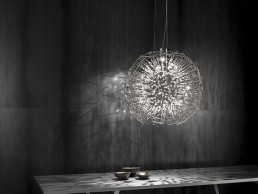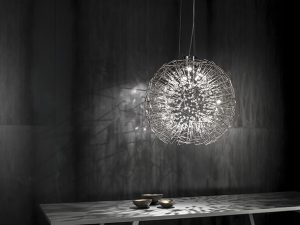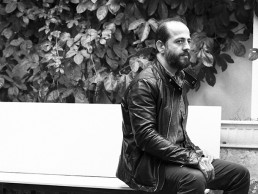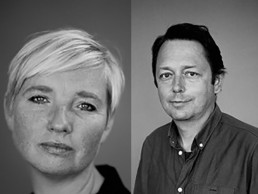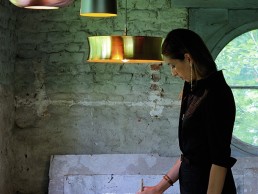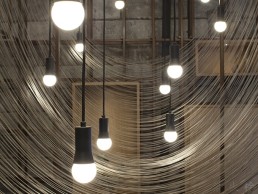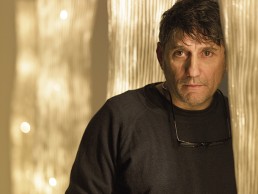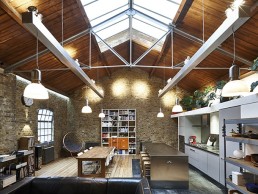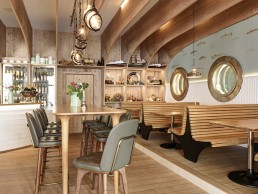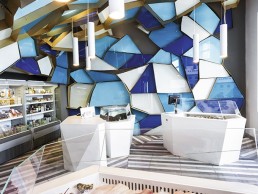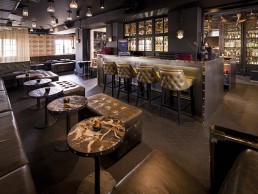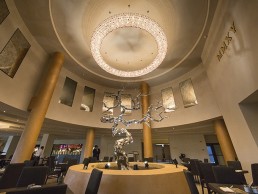Terzani Core
Core, designed by Christian Lava for Terzani, is reminiscent of the natural energy at the heart of our world. Like bright lava seeping through the earth’s crust, vibrant spheres of faceted crystal break through the iron surface of this pendant, resulting in a vibrant exchange of LED light and shadow.
Michael Anastassiades
This year’s London Design Festival saw the Atrium showroom open its doors to the international design community for the launch of a new FLOS collection, including lighting pieces from renowned designers Michael Anastassiades, Jasper Morrison and Piero Lissoni. In this exclusive interview with Michael Anastassiades, darc discovers a man that is humble in both his approach and achievements, finds inspiration from the arts world and is very much “enjoying the moment.”
With no one in his family involved in design, as a child, there was little opportunity for Anastassiades to be creative. Growing up in his father’s home country of Cyprus, having moved from Central Africa when he was five-years-old, it was here that he went to school and later completed military service; once old enough, he embarked on a journey to the UK that would see his career in design begin to take shape.
With no previous encouragement to pursue a career in design, Anastassiades began his life in the UK with a civil engineering degree at London’s Imperial College. “This seemed appropriate at the time,” he tells darc, “but half way through the course I discovered the Royal College and it was a completely different world to me.” Having been inspired by what he had seen, Anastassiades set himself a personal goal that after graduating at the Imperial College he would pursue a Masters at the Royal College, “this is where I really became exposed to a design education.”
Anastassiades really wanted to get involved with something creative at this time, having felt frustrated for a long time by the lack of opportunity. “This exposure to the creative world was overwhelming. It didn’t matter to me at the time what I was doing and so a general design course seemed like a balanced option. It was more of a natural progression from what I had done before, for me it was more about the exposure to that world rather than the details.”
Reflecting on some of his earliest designs, Anastassiades tells darc how he felt everyone around him had been in the design world for so much longer than him, completing bachelor degrees in design and so on. “It really was my first opportunity to learn about design and there were some great ideas out at the time. My degree project ‘Message Cups’ was interesting and I actually developed it into a limited edition piece.”
It was the early ‘90s, well before the widespread use of mobile phones and SMS communication and ‘Message Cups’ was a product designed for communicating in the domestic environment. “I was very interested in the role of electronics and how these affected our lives, the cups were used for the exchange of messages and obviously at the time, it was a very experimental project.”
Anastassiades’ designs have naturally moved on since these early days, including everything from chairs, to mirrors, tables and of course lighting among many other product ranges. But what is it that keeps him inspired? How does he continue to reinvent himself?
“I wouldn’t say that I ever had a role model I aspired to,” he says, “it was more that I was inspired by anyone that had something different to say. While I value the work of a lot of designers, I relate to the work of artists much more, as I find it so free and interesting.
“The creative process is an interesting one and I have been able to create a platform that is free in terms of creating products, but I also think great designs can come from a place of discomfort and restriction.
“Sometimes when finances are tight (and back then things were) it makes you creative in a different way – not necessarily better or worse, just different – the results are equally interesting. I feel lucky to now be in the position where I’m free to produce and create in the way that I do."
And through his collaboration with FLOS Anastassiades has learnt what it is to work with light; designing beyond the structural qualities of the object and looking at what happens when you turn the light on and off. “It has to work in two very interesting scenarios. When you turn a light on what happens is something completely different and you have to work to the perception of what you’re seeing is different. The light, the actual space that it occupies changes; the shadows its casts; how you move and how it relates to the space, all of these things are kind of powerful and there’s something quite magical about them – this is what attracted me to light.”
Lighting does not come without its challenges though and for Anastassiades it is necessary to distance himself from technology in order to design.
“You need to see the object from the poetry it has to offer and as soon as you don’t restrict yourself by technology I believe you can produce something great.
“I get frustrated by some of the developments in lighting technology. Lamps that have been discontinued to make way for LEDs; certain discontinued light sources were really beautiful and poetic in terms of their qualities. It had to happen of course, but the rate at which it has happened, has resulted in such drastic development of lighting technology that at times I feel frustrated, because it’s difficult to find the right light source for the designs.”
Anastassiades first met FLOS CEO Piero Gandini in 2011 during Milan Design Week - also the first time he had taken part in Euroluce, presenting his designs. Anastassiades was working on the String light design independently at this time and it was from here that the pair decided to collaborate… The rest is history, as they say! “It was one of those unexpected moments, there was no intention from either of us to pursue a collaboration in that direction, it just happened – the timing was right. I was also operating from a place of freedom in that I had my own company and could easily produce my own designs but I was interested in working with a bigger company that could realise certain ideas in a different way.”
Three new designs from Anastassiades were presented during London Design Festival: Captain Flint, a multipurpose, free-standing luminaire – the head of the fixture rotates through the vertical axis around the stem, allowing for ambient uplighting or a directional light source for reading. The notion of balance is prominent in this fixture, with the cone shade resting delicately on the stem; Copycat follows on from the success of the IC Light family, drawing further inspiration from the spherical shape. It is a sophisticated, simple piece, ideal for very different interiors and décors; a table lamp providing diffused light, it is made of two touching spheres that hold each other up in a delicate and poetic balance; Extra represents the purest form of elegance and is available in gold, brass, dark steel and polished aluminium to create mystery and depth in any interior.
“I would never consider working with anyone else in lighting,” Anastassiades tells darc. “Once you have a platform and freedom to create it’s superb to be able to operate in this way.”
Looking ahead for Anastassiades, while he doesn’t have aspirations to change the world or design a spacecraft, he is very much enjoying the moment and where he’s at right now. With some great collaborations and companies to work with, he comments: “I feel very lucky and excited to have the opportunities I do. Light exists in so many beautiful ways in nature, it’s something that’s always existed, even before humanity. I don’t think in artificial lighting you can ever imitate this beauty and we should consider ourselves very lucky if we are able to capture one of these beautiful moments.”
Rikke Hagen & Andreas Lund
With Scandinavian style trending at the forefront of current design, new lighting brand Watt a Lamp, for which Danish designers Rikke Hagen and Andreas Lund have created the Adjustable and Mould pendants, caught darc’s attention at Maison et Objet in September. With a memorable pun for a brand name representing their clean and playful designs, brand founder Michael Waltersdorf selected Hagen and Lund as curators to nominate a team of designers, including themselves, and to ensure the coherence of the first Watt a Lamp collection.
Discussing the duo’s work with Waltersdorf, Lund commented: “The collaboration with Watt a Lamp has been very close, with Rikke and I picked out to be consultants in developing the brand. It has been a great pleasure to work with Waltersdorf, who has been willing to challenge the market of lifestyle lighting – only through open minded playfulness throughout the entire creative process can one stand as unique.”
Establishing a position in the international design scene with a new lamp brand is not something that happens overnight, and often does not involve designers in shaping the brand until a late stage in the development process. Hagen discussed how their involvement with Watt a Lamp so far has differed: “Our role has been to define the basic parameters and tools for the design process between Watt a Lamp and the designers that we selected for this first collection.” Having been involved from the very beginning, there is a certain tenderness; a conversation between clean lines and gentle curvature that is evident in Hagen and Lund’s individual work and also emanates throughout the entirety of the Watt a Lamp brand.
This modernist, simplistic style has been instilled in each of the designers from a young age, having both spent their childhoods surrounded by definitive pieces in design. Hagen’s childhood was lit by Panton’s Globe lights installed on hessian-covered walls, as an Anglepoise lamp with its flexible and functional arm shed light on her father’s worktable. In the quiet residential neighbourhood in Denmark where she grew up, houses were based on Japanese-inspired Danish modernism with daylight pouring in through large windows and wood cladding as the new black, accounting for the minimalist lines seen across the selected designers’ works for the Watt a Lamp collection.
Having been exposed to the simplicity of Japanese design from an early age, these features are also apparent in other areas of Hagen’s career. After making a start in the world of fashion and textile, she moved towards industrial design based on her fascination with the technicalities of glass design, notably that of Danish glass designer Michael Bang. Shortly after graduating from the Royal Danish Academy of Fine Arts, School of Design, Hagen established a glass workshop with an emphasis on craftsmanship and form. Concurrent with this, her industrial design career began to take off; in 2004, she founded the design studio copen hagen, from which launched HAGEN ETC., her own brand combining design strategy, idea development, product development and production.
One of the first pieces under which Hagen’s passion for lighting design flourished was the Steam table lamp. Designed for Danish glass factory Holmegaard in 2008, the main feature of Steam is a bold turquoise cable snaking its way out from inside the lamp’s translucent lower half. Hagen commented on what it is about lighting specifically that appeals to her: “To me, a lamp is especially successful when the technical and functional aspects are implicitly present in the lamp. When you are not in any doubt about how to operate it; when the aesthetic design qualities are prominent elements that shape the mood in the room, and the functional aspects follow naturally.”
Hagen now works on her own designs under HAGEN ETC., while continuing to work on product development for Holmegaard and other Danish brands such as Normann Copenhagen. Wanting to design products that speak to the senses, she has several new product designs in the pipeline, including one for Georg Jensen due to launch next year. Similarly, Lund was surrounded by a varied profusion of creativity from an early age. Growing up in a family of architects, artists and craftsmen, he played as a child with wooden blocks from his father’s workshop, focusing on balancing constructions, which sought innovative solutions driven by a childish curiosity, an approach he has carried through to his designs in adulthood. After a carpentry apprenticeship, Lund received a scholarship to study traditional Japanese craftsmanship in Kyoto, Japan, “which ever since has been a great inspiration and leading path.” Highlighting the natural bond between the two artists, this Japanese-inspired Danish modernism stands at the core of Watt a Lamp, and resonates amongst the designers chosen by Hagen and Lund for the brand’s debut collection.
In addition to his collaborative work with Hagen, Lund independently designed the Play pendant for Watt a Lamp, based on the familiar analogue board game Ludo, and has also worked with Danish designer Jacob Rudbeck to create the Bell ceiling pendant for Normann Copenhagen, as well as pieces for premium modern living store Illums Bolighus. “The pendant is spectacular as a hanging sculpture,” Lund said of his partiality to the lamp form. “In working with a pendant, you also have the chance to make an iconic, graphic-like sign, hanging perfectly at eye level.” Lund’s attraction to lighting design lies in its unification of constructive sculpturing and functional needs in an everyday object. “Lamps are neither furniture nor objects; the human body does not relate to lamps like it does to furniture, but light creates a space, which in a very basic way, affects our body and behaviour.”
With a material preference towards steel and aluminium in lighting design, Hagen and Lund aim to make their designs affordable for ordinary people, with porcelain also capturing their attention for its “tactile quality”. Hagen and Lund’s main focus when designing pendants is to combine playfulness and graphic qualities that people need in modern homes. The lighting in a room is crucial for the way people use the space, how they move in it, and what sort of mood they perceive. “These are all elements that need to be considered in the design process for a new lamp,” commented Hagen. The pair maintain a focus on modern living, pertaining to the notion of simplicity and cleanliness that they have each been exposed to throughout their design careers and beyond. As a result, Watt a Lamp is characterised in the same modernist light, irrefutably begging users to exclaim “wow, what a lamp!” at the first simple and satisfied use.
Pic: Anne Mie Dreves
The Beacon, PNC Plaza, US
Created by design firm ESI Design for the PNC Financial Services Group, the Beacon is a data-driven media installation located in The Tower at PNC Plaza, Pittsburgh, US. The installation pulsates with shifting light, colour and sound patterns, expressing environmental concerns in its motions that allude to energy and water consumption, water recycling, use of artificial light and other environmental building indicators.
The Beacon is a 24ft high installation suspended from a central ring on the atrium ceiling comprised of 1,584 transparent liquid crystal polycarbonate panels backed with a grid of eight LED lights. Drawing on real-time data from the building systems, the installation expresses in real time how the building uses fresh air and sunlight to reduce its reliance on fossil fuels to create a comfortable and healthy work environment. Creating a striking and unique media canvas, the installation also shows how the building is recycling water and how much of The Tower’s waste is being diverted from landfill.
As specialists in experience design, to encourage the public’s engagement with The Beacon, ESI Design created a website accessible on any digital device located in The Tower lobby. Visitors to the site can explore the meaning behind The Beacon’s light and sound displays, as well as more about the building’s state-of-the-art technology and design.
According to Vice President of Creative Strategy for ESI Design, Gideon D’Arcangelo, The Beacon sets a new model for how green buildings can engage and educate the public about sustainable design, green technologies and the role that tenants and visitors can play in water and energy conservation, recycling and composting.
“Our goal in designing The Beacon was to transform the way people experience the building and communicate the invisible things the building does, behind the scenes, to maximise resources,” said D’Arcangelo. “The Beacon is a dynamic, data-driven media installation that is intriguing and beautiful to look at and hear. It also rewards the curious, by explaining itself and encouraging people to dig deeper to learn how the building works and how it is performing at any given moment.”
ESI Design deployed the same design philosophy it uses in producing engaging experiences for retailers, cultural institutions, museums and other public spaces under the leadership of interactive pioneer Ed Schlossberg. ESI drew upon the team’s experience and design expertise in a variety of specialised disciplines, including interactive, visual, and website design.
This empowering installation is more than just a structure to admire for its aesthetics. It serves a thought provoking and imperative function in its service to reflect what The Tower itself aims to achieve for environment. Undoubtedly, it will be admired for both its inner and outer beauty.
Images courtesy of Andy Ryan
Hind Rabii
Designers have a message they work to expose. They don’t do what they do for nothing. Whether they aim to access a certain space, be it physical or theoretical, designers create with a purpose that their products exude. So what is it? What do they want to say beneath material? In the case of Moroccan feminist and lighting designer Hind Rabii, it is some delicate core between technology and sensuality that coats the shades of her designs.
As a girl, a woman, an engineer, Rabii has found herself in the world of design discovering solutions to lighting problems. With a focus on soft lighting, she translates her gender and Moroccan heritage into a distinctive brand defined by a timeless amalgamation of culture and femininity.
Born in Rabat, Morocco, Rabii moved to Belgium to study engineering, where she felt she was at a crossroads with the many ancestral cultures and struggles of the world. “This prohibited me to be indifferent,” she tells darc, “so it has become critical for me to position myself within the feminist debate and on the topic of social justice.” Rabii felt the need to provide answers that would satisfy both herself and her customers, leading her to the conclusion that function generates form; this is now the basis of her brand, practice and technique.
Rabii’s lifelong love affair with the way light filters through fabric has been a continuous source of inspiration to her, leading to what she terms “the technical transcription of the lyricism” of her life as a young girl and as a woman. This approach has led to her exhibiting collections such as Belle D’I at events such as Euroluce, marking a new stage in her career as she continues to march ahead with the development of the Hind Rabii brand.
As a self-aware, independent woman, Rabii is conscious of the role that she can and will play within contemporary society. Between technology and authenticity, her collections testify to an inexhaustible desire of creation to achieve the essential: emotion. To illustrate the importance these attributes hold in her heart, and their relevance in contemporary society, she presents her emotion and practicality in design through elegant and sober lines that create a signature of their own.
Belle D'I
To exemplify her sensual and intelligent design ethos, Belle D’I has been created in collaboration with designer Luc Vincent, who also finds inspiration in iconic timeless shapes from both Morocco and Europe. “By changing the proportion of the lights, it not only helps you focus on the aesthetics but also to achieve quality lighting,” comments Rabii.
The Belle D’I collection is a harmonious combination of glass, textiles, aluminum, colours and materials, and was also the beginning of a large and varied range that has gone a long way in defining the brand’s aesthetic. “My collaboration with Luc Vincent has encouraged me towards this direction,” says Rabii. “Together we analyse my aspiration for the brand as well as designing the catalogues and the brand’s website.”
Rabii and Vincent have created a graceful design in glass with a timeless air of Moroccan culture and heritage. “The sensual hips of this model make it quite unique,” described Rabii, with the basic shape defining its prioritisation of use and material. Available in two sizes, there are four Belle D’I collections for 2015; Belle D’I, Belle D’I Chic, Belle D’I Tech and Belle D’I Pleated. Each of these collections exhibit the technicality and intelligent feminism that is integral to the Hind Rabii brand.
Images courtesy of Nicolas Schimp
The Noodle Rack, China
Noodle soup is a common street food all over China. While most of these noodle eateries spend tremendous effort to win customers over with taste, some have started to add attractive store design to their branding recipe. A good example is LongXiaoBao, a newcomer which set foot in Changsha with an ambition to spread the local ShaoYang style rice noodle to the rest of China. Commissioned to conceive a contemporary identity for its first restaurant, Lukstudio integrated the tradition of noodle making into the spatial design by reinterpreting a noodle rack.
Nestled along an outdoor shopping promenade nearby the Xiangjiang River, the 50sqm noodle restaurant exudes a calm yet mysterious presence with its bamboo-cast concrete storefront. Two rustic steel boxes penetrate through the solemn exterior: the taller one cladded with rusted steel panels and its shorter neighbour built like a metal scaffold. These three elements together orchestrate a journey of discovery, illuminated by Tons exterior strip lights and ODL-003P in-ground luminaires.
Walking past the entry box, customers are greeted by a composed counter design lined with the bamboo mold used for casting the exteriors.
Continuing on towards the halo surrounding the grid structure, the interior layers start to reveal themselves. Firstly, the original wall has been stripped down to its structural blocks to resonate with the rustic metal grid; secondly, wooden boxes have been carefully placed within the rack to showcase selected porcelains, illuminated by Tons DA-501AD display case luminaires. Finally, a series of metal wires are draped across the dining room to create the focal lighting feature created by 85 custom-made pendants. Included in each luminaire’s design, the bespoke metal casing was made to hide the upper plastic part of the LED dimmable lamps. These lamps were ordered directly from the factory by the contractor according to the specifications in size, wattage (7W), and 2,700K colour temperature. Balancing the rustic interiors, these reflective strands create a poetic notion of dining under a noodle rack.
Additional decorative elements include jiu wall lamps from Bentu, used to create atmosphere at the restaurant’s counter and Morning bamboo table lamps from Sozen, providing warmth in the concrete space.
Playing with the duality between rustic and refined, eastern tradition and western representation, Lukstudio has introduced a crossover between fast food chain and upscale diner. The Noodle Rack differentiates itself from the stigma of kitsch fast food ‘hole in the wall’ available on every street of China. It demonstrates how Chinese eateries have the potential to be reborn into hip gathering spots comparable to the new trend of cafés.
Pics: Courtesy of Peter Dixie for LOTAN Architectural Photography
Arturo Alvarez
Born in the countryside of Galicia, northwest Spain, designer Arturo Álvarez moulded his career from the beauty of the Atlantic forest, the extraordinary sea and surrounding mountain ranges. He was an observant child, an autodidactic learner from the start, making his own toys and experimenting with any object that fell into his hands.
Having first been introduced to the mechanics of lighting while working at a furniture factory in the field of electric maintenance and assembly, his pull towards lighting design began with a curious exploration of the Tiffany technique, based on American artist Louis Comfort Tiffany’s work with stained glass and lamp design.
“Working in lighting happened by chance. I consider it a way of expression like any other. I could have chosen to make jewellery, furniture or clothes… I’m attracted to lamps because of their light; they shine.” said Álvarez. His career blossomed with time and through the public’s positive reception of his work. Álvarez is now the lead designer of his own design brand, arturo alvarez, comprised of himself and other designers. Together they have created a laboratory of ideas, combining ingenuity, innovation and technical experimentation with the philosophical ideals of the company’s ethos.
From tactile beginnings, Álvarez has developed an ethereal and organic style, while maintaining that his products must be able to adapt to any kind of project in a harmonious way, adding value to and highlighting a project as a whole. With his signature style, Álvarez pays no attention to trends, finding them “restrictive and frivolous”. In his work, he combines functionality with beauty through the varying textures and transparencies of form and material. He absorbs and exudes a professionalism that searches for different paths and explore new languages of expression through experimentation, consequentially.
This signature style can be seen throughout his projects, a more recent and notable one having taken place in Porto, Portugal at the InSpiritum music festival. A piano and violin concert resounded through a magnificent historic building in which arturo alvarez’s lamps harmoniously blended with the surroundings and musicians. Álvarez’s work has also been displayed as visual art as part of a collective exhibition in a contemporary art museum alongside other artists.
All the accumulated experiences of his life have influenced his career to shape his work into what it is today. “The landscapes, my travels, the people I meet, animals, the marvellous textures of nature… My home and studio are full of branches, seeds, leaves, shells and stones,” he said. Inspired by all things natural, Álvarez most admires Spanish architect Antoni Gaudí, commenting: “I’m impressed by his experimentation in different trades and how he integrated a variety of techniques in architecture.”
In his own work, Álvarez pertains to the same ideals stemming from natural inspiration to experiment with unlimited creativity and lack of boundaries. “That for me is very important and sets an example to follow.”
Looking ahead, Álvarez aims to evolve as a creator, making pieces that transcend the utilitarian in order to create other relationships with the public, to open other dialogues and paths of reflection. Referring to pieces such as the Encontros illuminated figures, or the use of shadow in Conversas, “I see myself going deeper into this field in years to come,” commented Álvarez. As part of this development, a recent project saw him patent his own material, SIMETECH, a handmade material composed of a stainless steel mesh with a silicone covering application. Álvarez continues to explore textures and delve into new materials, “an aspect of my work I truly enjoy.” Seeing infinite possibilities in all his projects, Álvarez thrives off unpredictable exploration and expression of light. “I will go on working, researching and exploring, just like when I was a child.”
My Loft Kitchen, UK
When world champion kickboxer Jon Lawson turned his hand to creating high quality cuisine, he learnt to perfect his craft under the watchful eye of Theo Randall of London's The Riverside Café. And when the time came to create My Loft Kitchen, an intimate, high quality dining experience and part time pop-up restaurant in his private east London warehouse apartment, he looked to the talent of Ben Rousseau and his team at Rousseau Bespoke Design.
Working alongside Lawson’s architect partner Valeria, together, the threesome discussed how they could make the most of the industrial space while celebrating its features. The apartment had to function as an entertaining home with a beautiful ambience, as well as a pop-up restaurant that celebrates the cooking and dining experience; as such, a very specific lighting design solution was required.
The space was split into four zones; the preparation area with clear task lighting for diners to view the chef's skilful work; the dining zone; the DJ area; and a personal lounge space. These areas work individually and together to create a wholesome dinner party experience.
For Rousseau, the high vaulted ceiling with its industrial steel girders running across, dictated the initial design concept.
“By the nature of how the customer wanted to use the space, it made sense to create two six-metre-long custom fabricated aluminium joists that we could suspend from the ceiling via fine steel cable and mount four pairs of directional twin 3,000K uplights,” Rousseau tells darc. “This allowed us to show off certain feature areas and reflect a warmth off the timber ceiling cladding in order to make the space feel very cosy and intimate, celebrating the industrial architecture of the space. It also allowed us to hide all of the digital control units and dimming modules from Rako for the AR11 multi-directional spot lights.”
For the different zones, three pairs of industrial pendants provided by the client were tidied up and rewired by Rousseau, with E27 lamp fittings and large LED squirrel globe lamps with a sand blasted glass shade.
As the client already had galvanised steel conduit feeding certain light fittings, Rousseau and his team added a few more runs in discrete locations to feed the new light features. Up / down LED wall lights were positioned to add interest on the walls, below a cooler white LED strip light creating a halo effect on the timber joists running close to each wall. As the warmth from the brick and timber structures needed to be highlighted, Rousseau used different temperature lighting to add dimension and detail.
“We hid the light source behind a timber joist that ran along the very top of the wall as I usually like to conceal the source,” Rousseau tells darc. “In between the windows is a DJ booth, to which we also added detail by using two up / down lights in the same 3,000K range with a wide beam below and a focused beam going upwards, to frame the wall around, and above the DJ booth.
“Each of these items were set at good levels in the Rako control system so that the customer has very flexible pre-sets for the different functions of the zones, both collectively and as individual areas.”
As it should do, the lighting in the loft kitchen makes the space come alive, celebrating the features and providing flexibility that enhances the user’s experience. “The new baulthaup kitchen now sits among a collective of good design, function and desirability,” says Rousseau. “With good lighting, the clever trick is making it work without anyone really noticing.
“From the beginning, the ideas were really focused and then executed really well with the help of my electricians at Harpenden Electrical, who were brilliant and efficient as usual.”
Reflecting on the project, for Rousseau, this was a job well done and while accessing the building with the huge customised joists was a challenge, there isn’t a thing he would change. “I think it works really well, the customer is very happy and I think it delivers everything I expected it to,” he says. “It is a huge leap from the static, gloomy fittings that were there originally.”
www.facebook.com/myloftkitchen
Pics: Jake Fitzjones
Hafen Restaurant, Switzerland
An attractive urban space along the shoreline of Lake Constance, where the Swiss lakeport town Romanshorn and the SBS Swiss corporate shipping line meet, hosts the newly designed Hafen Restaurant. Erected on a promenade built into the lake, Susanne Fritz’s firm, Virtual Design Unit based in Zürich, created an interior for the restaurant characterised by ships and the seafaring world, with a bright and breezy lighting scheme to match.
Following the recent rennovation of the SBS shipping line's port building and shipyard as historic landmarks, Fritz had a challenge in transforming what was a former storeroom into a restaurant, fully symbolic of nautical science while pertaining to the building's historic function. Project managed by Benno Gmür, a delegate of Virtual Design Unit’s administrative board and reorganiser of the company, the team maintained many of the structure's original features, while focusing on the potential of additional details to create an interior theme relating to the location's heritage.
Five portholes were inserted into the side-walls with diameters of up to 1.4m, envisaged to create transparency vis-à-vis the adjacent premises and optically enlarge the space, which is only around 150sq.m. To link the ship theme with the directly adjoining offices belonging to SBS, both the ticket hall and access to offices leased to third parties on the upper floors were redesigned as well.
Restaurant guests are greeted by Karlskrona Lampfabriken's Heidenstam Bowl lamps in the immediate entrance, which opens up into the central dining and bar area, where Davey Lighting’s aluminium pendants are suspended above tables and Nattlampa oil lamps providing direct light on each table, also by Karlskrona Lampfabriken. Guests can help themselves to a buffet of seafood and other freshly prepared foods in the centre of the dining area, where Original BTC’s Ginger Bracket Wall lights feature on the central fish-printed pillar for additional illumination.
Although a large-scale kitchen to provide catering for the shipping trade was already in place at the rear of the building, a portion of the restaurant was sacrificed in favour of a satellite kitchen to keep routes short and workflows efficient. A curved ship’s prow adjoins the kitchen and acts as a bar counter and serving area to integrate the galley overlaid with steel bands and white painted metal sheeting. Protruding wooden ribs form an eye-catching design feature, visually obscuring the view of the ribbed ceiling; they merge into the rear wall of the restaurant, where trays and cabinets have been integrated.
An alcove with benches akin to those on the passenger boats that tour the lake offers porthole views of the underwater landscape on the opposite wall area. This area features a bar-stool table for more casual dining, where Czech designer Katerina Handlova’s Shibari pendants are suspended via rope tied around the glass. This lighting is based on the Japanese bondage technique called Shibari, wherein each part has its own binding that creates a kind of ornament.
The WCs are also in keeping with the nautical theme, with sparkling tiles ranging through the shades of the sea, enveloping guests in an underwater world. The walls glisten under the illumination of Original BTC’s Pillar Light Narrow Polished Brass wall fixtures on either side of the mirrors.
All of the restaurant’s pendants are flexibly and adjustably mounted on track lighting systems to fit in with the varying seating arrangements throughout the seasons.
Inspired by its surroundings and history, Fritz created in Hafen, a seafaring spacious and light environment for diners to enjoy each other’s company and delicate dishes. With an expansive view of Lake Constance and a nautical interior with details akin to those found on a ship, the restaurant is a truly unique dining experience lathered in the wonder of the underwater world.
Pics: Pierre Kellenberger
Poissonnerie Nemeau, Canada
Inspired by Jules Verne’s adventure novel Twenty Thousand Leagues Under the Sea, Montreal-based creative designer Jean de Lessard’s unique signature resonates through his recent Némeau project. With more than 25 years' experience and lead designer of his own firm, de Lessard has transformed a variety of interiors, each marked with his signature style of eclecticism, durability and functionality. Like his client, Poissonnerie Némeau, de Lessard took a fresh look at the traditional fish market through his own atypical lens. "I approached this project from the vintage viewpoint of Jules Verne, but through a time line between today and tomorrow. It's subtle, a little crazy, but fun!" he said.
Led by the breakdown of interpersonal relationships and physical boundaries to redefine the concept of interior space, the brand image of this 430sq.ft store located in Lévis, on the south shore of Québec City, is based on the same pioneering spirit. The fish market offers customers the chance to discover fish products in a new way by providing them with a unique promenade-shopping experience.
The concept of adding value to products through exploration is the main theme of a rather unusual design, which aims to be a journey of the senses around displays brimming with fresh products. "It facilitates interactions between staff and customers and adds a distinctive touch to the collective experience; shopping becomes enjoyable even in such a small space," commented de Lessard.
In this dynamic and minimalist space, the combination of horizontal and vertical lines and transparency brings to mind the emptiness and fullness within the depths of the sea. The oblong-shaped, ethereal lighting, custom designed by Nemeau and manufactured by Lumen, appear as abstract vegetation suspended in space, balancing the denser shapes on the floor.
Ice-floe displays are randomly articulated around circulation axes, inviting gazes and a gourmand inspection of their content. These stylised cooling systems topped with asymmetric glass cases were custom designed to evoke jewellery boxes, holding the contents of the sea’s jewels. The sculptural glass ceiling, with a prismatic shape and tone illustrates its underwater magic, becoming a form representation of the refraction of natural light on water. In one fluid motion, the striking honeycomb ceiling becomes a sweeping tsunami of shelves. This is a simple, practical and ingenious way to maximise the store area surface. The white and grey ceramic tiling is reminiscent of the slats of hardwood of a boat’s deck, emphasising the nautical theme.
Through a delicate play of natural light, reflectivity and custom designed ethereal light pieces, de Lessard has created an otherworldly shopping experience. He uses light and colour to draw attention to the elegance, delicacy and magic of the nautical world and all its inhabitants, rendering the fish shop a pleasurable experience for all.
Pics: Francois Laliberté
Hotel Gotham, UK
At No.100 King Street, Manchester is Hotel Gotham. Housed in one of the city’s grandest listed buildings and the former premises of Midland Bank, it stands tall and proud amidst architectural nods to the Grecian and Baroque. Drawing inspiration from its surroundings, Gotham aims to be nothing but unique. Speaking to interior designer Oliver Redfern, darc discovers how intrinsic the lighting is to the hotel’s design.
Since graduating from Cardiff University with a degree in Interior Architecture, Oliver Redfern has amassed seventeen years of industry experience, a large part of which was spent with UK retailer Laura Ashley where he headed up the Commercial Design Service. Having worked on a varierty of commercial projects throughout the UK and Europe, including Alladale Lodge, a wilderness reserve in the Scottish Highlands, which featured on the BBC documentary The Real Monarch of the Glen in 2009 and ranked in Tatler’s Top 100 Places to Stay, Redfern went on to establish himself as an independent interior designer in 2006.
What was the brief for Gotham? I was introduced to the project via Robin Sheppard, chairman of Bespoke Hotels, his brief was simple, create a fun, witty and a little bit of a naughty hotel inspired by the Art Deco period.
What appealed to you about the project?
The building was just so striking; towering up from street level with a quality and presence I associated to a New York skyscraper. Having studied Edwin Lutyens at university and visited many a time his Castle Drogo project on Dartmoor, I felt that I had some understanding and experience I could draw upon.
What was the design concept?
For me, the initial challenge was to ensure the interior had the same wow factor as when you approached the building. This sense of drama was created with decadent finishes, muted palette and of course, clever use of lighting, all ensuring a moody nostalgia.
What role does lighting play in the design?
Whit and mood...
From the beginning it was clear that lighting was key to ensuring the building’s past was told, along with providing the guest with an almost fantasy experience, making them feel part of something special.
There is in-fact a story told within the lighting; the inverted umbrella pendants in the lobby represent the arrival of the old banking staff on a wet Manchester morning, while the sixth floor Honey restaurant lighting is all about the banking staff offices, with traditional green glass wall lamps and adjustable nickel spotlights. The journey ends in the private Brass bar on the seventh floor featuring bespoke antique leather briefcase pendants as you enter. These are lined in a gold effect and were originally meant to represent the office worker throwing off the shackles of a hard day and enjoying themselves. Although in hindsight, I wonder if it looks more like an opportune office worker has made good with a gold bar or two!
How does natural light add to the hotel?
From my very first site visit it was clear the huge windows would not only be a beautiful feature across all the floors but also afford the most wonderful light for guests in the bedrooms. This is the very opposite to the more moody experience of the public spaces and corridors.
What was the biggest challenge?
Plenty of midnight oil was burned while working on the five Inner Sanctum Suites at the core of the building. These were designed in the old light well and are meant to completely envelop the guest’s senses and overcome the lack of natural light. As guests enter a darkened suite they turn down a corridor, which opens into the main space, helping to disorientate their senses before being presented by the ‘Wonderwall’ - a wall-to-wall screen designed to emulate the building windows, complete with a skyline film of Manchester projected onto it. Then just for a bit of Gotham’s own magic, the dummy window frame slides open by remote control to reveal a huge Plasma TV.
Does the the final outcome reflect your initial design concept?
Difficult to answer, as I am sure I was still tweaking the design right up to the day Gotham opened, well in my mind anyway! But I never felt there was a compromise and any changes made only enhanced the finish.
A.Roma Lifestyle Hotel, Italy
Located 20-minutes from Rome city centre in Valle dei Casali, the A.Roma Lifestyle hotel and conference centre, is a newly built luxury hotel of LDC Italian Hotels. With the interior design realised this year by the hotel operators general contractor Techbau, the project consisted of the hotel’s refurbishment and completion, including the selection of all furniture and decorative elements.
Offering panoramic views of the capital from the rooftop lounge and terrace, the hotel complex includes 276 rooms, a restaurant to seat 400, conference rooms as well as spa and well-being facilities. In accordance with LDC Italian Hotels’ ideas of hospitality, the A.Roma hotel is also intended as an art gallery, with visitors can enjoy works by contemporary artists and antiques to celebrate the rich culture of the hotel’s surrounding area.
Each area of the hotel is identified by a combination of technical and decorative lighting elements, including Lolli e Memmoli’s Ugolino System circular bespoke chandelier. Designed specifically for its environment, the custom four-metre diameter chandelier features a clear and purple crystal pendant finish, installed in a circular space of a twelve-metre diameter. From the double level around it, mirrored windows multiply the view of the chandelier, which guests can marvel at from the double level around it.
With a reputation for pampering guests with luxury and comfort, Lolli e Memmoli’s chandelier makes an extravagant statement of lavish style, reflecting A.Roma's celebration of Rome’s rich culture.


